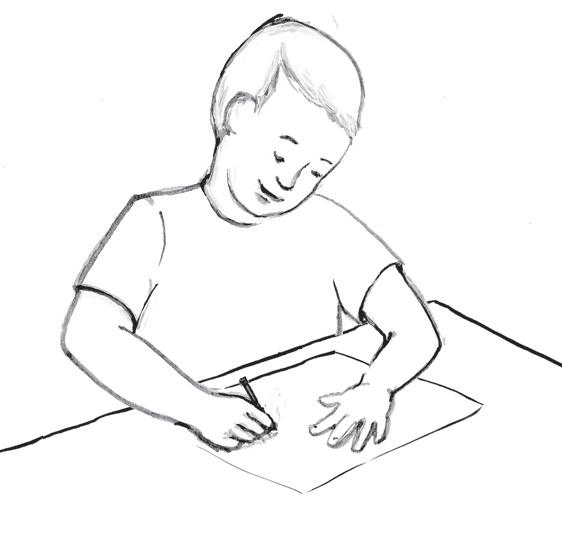
5 minute read
Scope & Sequence
PRE-INSTRUCTIONAL STAGE – PRE-K, TRANSITIONAL KINDERGARTEN, AND KINDERGARTEN
The focus is on building readiness skills essential for learning. Pre-instructional readiness activities promote social-emotional learning, fine motor skills, drawing, coloring, alphabet knowledge, pre-writing, writing, number, and counting skills. Most handwriting lessons will begin with multisensory hands-on learning, which will boost these skills prior to writing letter and numbers.
INSTRUCTIONAL STAGES
Because research shows that children can imitate months before they can copy lines and shapes, the first stage of handwriting instruction is demonstration-imitation. When you demonstrate, children can see your physical motions. They imitate how you move to write a letter or number. For handwriting success in your classroom, use these three stages.

Stage 1 – Direct Instruction (Demo)
The child watches as the teacher writes and then imitates. Ready for next stage?
• No: Do more multisensory activities. • Yes: Let children finish a student edition page by copying models.
dog
Stage 2 – Guided Practice
The child looks at the completed model of a letter, word, or sentence and copies it to match the model. Ready for next stage?
• No: Go back to demonstrating the letter. • Yes: Supervise copying.
Stage 3 – Independent Practice
The child writes unassisted, without a demonstration or a model.
You will know when your children are ready for independent writing when they can:
• Write their names correctly. • Write letters and numbers from memory. • Write dictated words (assist with spelling). • Enjoy free writing.


THE HANDWRITING PROCESS
Good handwriting skills result from your thoughtful attention and instruction. Students need deliberate instruction to develop good habits and overcome bad ones.
With this guide and Handwriting Without Tears® materials, you will be prepared to help students make writing a natural and automatic skill. You’ll find that their handwriting abilities and habits vary. Regardless of where they start, you can help them develop and improve their skills:
TEACH
How to hold the pencil correctly
TO FIX

Awkward pencil grip
Letters/numbers that face the right way Reversals


Letters/numbers that start at the top

Letters/numbers that are formed correctly and consistently Starting at the bottom


Incorrect letters/numbers

Handwriting is an essential component of a complete literacy curriculum, and can be integrated within daily literacy activities. Our handwriting lessons take 10–15 minutes a day. It’s easy to connect your handwriting lessons to parts of your literacy block. Below are some possibilities:
Guided & Independent Reading
Instruct students on the formation of letters and words from the text after shared reading.
Guided & Independent Writing
Take turns practicing a specific letter's formation during interactive activites.
Word Work & Phonics Provide direct instruction on features of the letters in target words. Utilize Handwriting Without Tears mulitisensory activities to practice correct letter formation while writing words.
Integrating Handwriting & Reading
The three options below work best because they adhere to the fundamental principles of each discipline and incorporate lesson work from each in a way that fully supports skill development. Find one that works best for you. In the Lesson Planner in the Interactive Digital Teaching Tool (IDTT), you can modify the lesson order to align to any one of the following sequences.
1. Separate the handwriting and reading teaching order
Teach both programs in the recommended orders. Keep instruction separate until familiar letters appear. Then remind children of letters they know from handwriting or reading instruction. • During handwriting, remind students of letter sounds they know. • During reading, remind students how to write letters previously taught.
2. Integrate the handwriting and reading teaching orders
Teach both programs in the recommended order, but make connections between them to facilitate learning. • During handwriting, integrate reading instruction for that letter by saying, “We are learning to write letter a. Letter a makes the /a/ sound.” • During reading, integrate handwriting instruction for that letter by having students finger trace the letter in their handwriting books while you say the letter’s formation. Or, print additional practice pages using
A+ Worksheet Maker.
3. Follow the reading teaching order
Teach both reading and handwriting in the reading teaching order. During handwriting, simply go to the letter teaching page you are covering in reading. Complete the word and sentence pages after you have taught all the letters.
Children will develop emergent writing skills in a developmental sequence from scribbling to conventional spelling. This begins with young two-year old’s random marks and scribbles, progressing to children forming lines and shapes in preparation for writing letters. Between four and five years of age there is an obvious interest in forming letters through exploration.

2–3 year old (random marks) 3–4 year old (starting to draw person, letters)
4–5 year old (writing letters, name)


Supportive Ways to Promote Emergent Writers
• Provide natural opportunities to explore strokes and shapes, for example, drawing at an easel. • Include movement and play activities to teach position in space, left-right discrimination and basic foundation skills. • Include intentional multisensory letter play as part of your daily routine. • Teach grip and provide tools to promote an effective grip. • Boost children’s vocabulary and listening skills through books and storytelling. • Encourage children to draw pictures to express themselves and tell a story. • Ask children to tell you about their pictures and write their response. This allows children to see how print has meaning. (see below).









